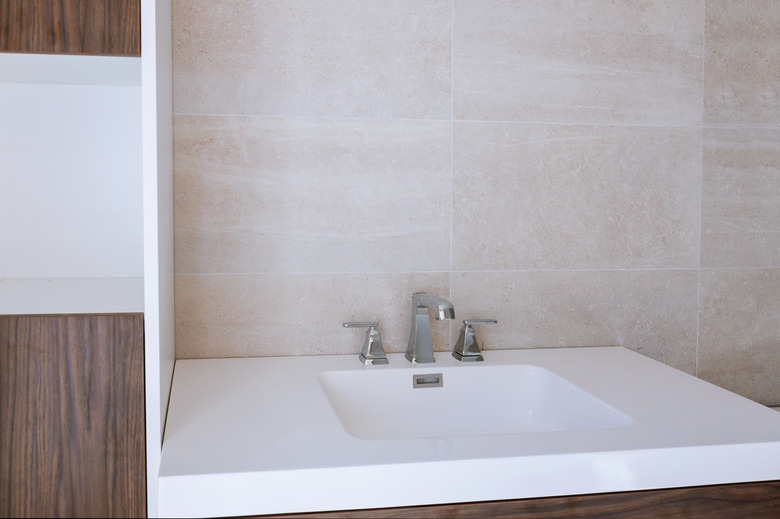How To Repair Porcelain Enamel With Rust
We may receive a commission on purchases made from links.
Porcelain enamel sinks and bathtubs may rust over time, particularly near the drain and fixtures. Rust can appear in your sink or tub and leave a red, orange, yellow or brown stain. This is most often caused by iron in the water.
Try Home Remedies
Try Home Remedies
Slowly stir a small amount of lemon juice into borax, a traditional natural-source laundry additive, to form a paste-like consistency. Apply the paste to the iron stain and let it set in for a few minutes. Once the paste has dried, rinse it off with water. Repeat until all the rust has been successfully removed. Dry it off with a paper towel or cloth towel. Always wear gloves when cleaning with borax since it can be harmful if it comes into contact with your skin.
A pumice bar is another option. Pumice is a volcanic rock made of a rough textured volcanic glass. It can be used as an abrasive scrubbing and cleaning tool. First wet the pumice bar, and then the sink surface. Scrub the iron off the drain. Repeat until the iron has been removed. Rinse off with water.
Alternatively, mix fresh squeezed lemon juice or bottled lemon juice with salt to make a coarse paste. Apply the paste to the rusted areas of the sink or tub, then let it sit undisturbed for several hours or even overnight if possible. This will allow the mixture to really set in. Scrub the rust away with a microfiber cloth or a toothbrush. Rinse it off with water, and repeat if necessary. This homemade cleaning solution leaves your sink or tub smelling fresh.
Use Commercial Cleaners
Use Commercial Cleaners
You can also use commercial cleaning products for sink rust repair. Always read the label to make sure they are compatible with your sink or tub. Bar Keepers Friend, Limeosol, Zud and Magic Eraser are all easy-to-find cleansers that may help with rust removal. Do not use products containing bleach, however, since this is not helpful for rust removal and may even make the problem worse. You can also moisten the rough side of a sponge to scrub away stubborn rust on the bottom of the bathtub.
For heavier rust buildups, especially in combination with limescale stains, you might prefer to use CLR and Lime-Away. Read the label first to make sure it is compatible with your sink and drain. These products can be purchased at hardware stores or grocery stores. They caution against using steel wool and scouring pads since these are harsh abrasives and can scratch the sink surface and cause damage.
Bath and Sink Rust Repair
Bath and Sink Rust Repair
If cleaning the rust alone is not enough, you may need to repair the enamel. Begin by removing the drain stoppers and flanges. Next, clean the rust using one of the methods above. Repair the enamel using porcelain filler and repair. It may take several coats to get the desired result. Allow the porcelain filler to dry. Paint over the repaired area with Sheffield Porcelain Touch-Up. It comes in a variety of colors to match your sink or tub. Allow it to dry. Be sure to ventilate the room properly when using these products.
Now replace the flange and drain stopper. Before replacing the flange, apply plumber's putty in a ring beneath the edges. This will create a watertight seal around the drain. Allow the putty to dry and set before resuming use of the sink or tub.
Get to the Source
Get to the Source
Since many rust stain issues are caused by the water in your home, you may need to get your water tested. Plumbing experts can come to your home and test your water to measure the levels of iron in your water. The iron content in your water may be high, causing rust to show up frequently. The plumber may recommend a water treatment system to remove iron from your home's water.
You can help prevent rust stains by wiping the sink or tub dry after each use with a paper towel or cloth towel. This prevents water high in iron from siting on the surface. When the iron sits on the surface and mixes with the air, it oxidizes and turns into rust. This will show up as rust stains and rust scratches in bathtubs and sinks.
